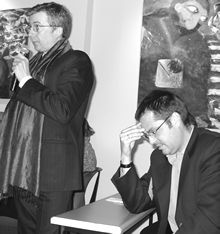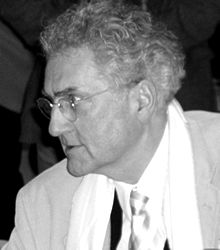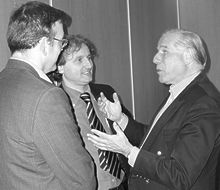
VOL. 5, NO. 3 -- SUMMER 2003
First New Urban Council Held in Brussels; 15 Countries Represented
|
|
More that 20 years ago, a young architect wrote "The
Reconstruction of the European City." He declared, "If ever I was to head
this Royal Institute of British Architects I would probably enter this
building, in the thick of the night, and with my own hands I would plaster
up that memorial wall which is covered in names (the list of Royal Gold
Medallists inscribed in the entrance hall of the RIBA building in London),
for most of these names have, more than any other names, contributed to
the destruction of European cities and culture."
Today, Léon Krier continues to adamantly pursue the physical health of
the European city. He and about 75 other architects and urbanists recently
convened at the first European Council, held early this spring in Brussels
and Bruges.
Organized by Joanna Alimanestianu, an architect and urbanist practicing
in Brussels, with assistance from Christian Lasserre and John Massengale,
Lucien Steil, and Andrés Duany of the New Urban Council, the group of
American new urbanists and their European counterparts met for five days
and engaged in discussion. The group shared their techniques for placemaking,
as well as their unique European or American perspectives on urbanism.
This acknowledged their unique place in the global picture, both their
differences and commonalities.
The group critiqued CIAM's post-war policies, which continue to erode
European traditional cities by the segregation of uses through zoning,
and of urbanism implemented as homogeneous public housing projects and
freestanding object buildings symptomatic of an automobile culture.
"CIAM applied numbers to planning, which appealed to American sensibilities,"
said urbanist Andrés Duany, one of the founders of the Congress for the
New Urbanism (CNU), convening the group. "Léon Krier said once, 'Let's
reinvent CIAM,' and from that the foundation for CNU was established."
Duany continued, "Our opponents are mired in relativism. They are uncertain
about everything. New urbanism has filled that void because we can discern
the good and the bad."
|
|
In reaffirming his belief in traditional cities, Krier
said, "True science is like rational tradition. No one needs to be told
in a technical way that one should not eat by poking your fork into your
ear. CNU is part of that tradition: Revive things because they work, while
saving the technological traditions that work."
The Americans made presentations on techniques and tools that continue
to be refined in the states. Galina Tahchieva discussed town-making techniques
from the DPZ portfolio; Elizabeth Plater-Zyberk and Victor Dover spoke
about the new urbanist public process; Peter Swift presented the traffic
engineering reforms proposed as alternatives to the current street design
standards; Chuck Bohl presented the recent developments in retail centers
modeled after traditional Main Streets; RAMSA architect Paul Whalen described
the design for Celebration, a prominent new town in Florida; and Duany
discussed new urbanist publications, necessary for educating the general
public.
Approximately 40 Europeans attended the new urbanism council from 14 different
countries. Presenters included Gabriele Tagliaventi, who presented his
projects in Italy; Paul Murrain, executive director of The Prince's Foundation
in the UK, an organization that promotes a return of human values to architecture,
the building arts, urban design and regeneration; Britain's Robert Adam,
who presented a summary on European regionalism; Maurice Culot, from France,
who spoke about urban work and counterprojects; Italy's Pier Carlo Botempi,
who spoke on regionalist (Parmesan) influences; Duane Phillips, DPZ's
director of planning in Berlin, who presented urban infill projects in
central Berlin; and new urban theorist Leon Kriér, currently living in
France, who spoke on tradition and its sustainability.
|
|
The five-day council culminated on the last day with
the formation by the group of the Congress for European Urbanism. In American
charrette mode, the group drafted a list of action items and scheduled
follow-up conferences to take place within the following 18 months.
"We can already see the effects of the positive synergy that emerged from
our first few days together. It has brought a gush of fresh energy into
the stagnant, isolated and fragmented Old World but also a means to trans-Atlantic
teamwork," said Alimanestianu, on location at a Las Vegas charrette.
The group identified 12 challenges, which included: degradation of public
places; disposable buildings; destruction of villages through decay, abandonment
or suburbanization; and car-dominated design standards.
It seems that new urbanists, regardless of which side of the pond we're
from, have much in common.
For additional information see http://www.intbau.org/CEU.htm


